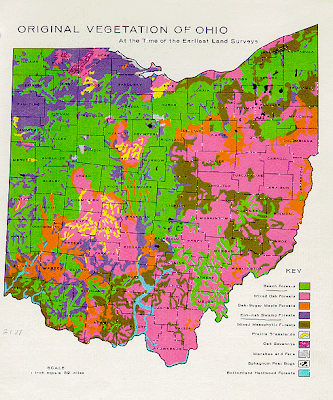Lake Erie and the surrounding marshes are magic- and just like magic- they are disappearing before our very eyes.  Think of the incredible pressure development has put on these natural bird and wildlife sanctuaries. Cedar Point Amusement Park- home of the Blue Streak was once home of the Great Blue Heron. Condos, marinas, restaurants- all concentrated on the lake shore- have certainly made a tremendous negative impact on our wildlife.
Think of the incredible pressure development has put on these natural bird and wildlife sanctuaries. Cedar Point Amusement Park- home of the Blue Streak was once home of the Great Blue Heron. Condos, marinas, restaurants- all concentrated on the lake shore- have certainly made a tremendous negative impact on our wildlife.
Here is the original vegetation map of Ohio- purple indicates wetlands. See the purple stuff in the Northwest corner? That was the Great Black Swamp; now only 5% of that area remains wetland. Perhaps it is due for a name change: The Little Black Swamp. Were it not for Ottawa National Wildlife and the State of Ohio's holdings, I fear our migrating birds would have no place to "fall out" during migration.
Here is a "bird's -eye-view" of the Marblehead Peninsula from the sky- (shot out of the airplane window as we were headed west on vacation)
...
Spring and fall each year, a miracle goes on above our heads. Birds migrate to and from their breeding grounds in Canada and beyond. Their only hope for continued survival is to cross that lake in hope of successful nesting. Each year hundreds of thousands of birds need to make a critical "re-fueling" stop at the wetlands along Lake Erie: Metzger Marsh, Ottawa National Wildlife Refuge, Magee Marsh, Sheldon's Marsh, and Old Woman Creek.
...
These are all critical habitats for our avian species.
And now, these birds are being handed an obstacle course to maneuver on take-offs and landing. Radio towers, buildings and a new danger- wind power.
...
The thought of greener, cleaner energy is music to any environmentalist's ears. But if wind turbines are placed at the intersection of two major migratory flyways, it is hard to believe it won't become a massive slaughter. This is not something that could happen in the future- this is happening NOW. The Black Swamp Bird Observatory needs our help to put the brakes on this wholesale disaster- before it happens.
...
- Please sign their petition for a 3 year moritorium to study the effects on wind turbines on the birds passing through the Great Lakes. Please go here.
- If you really want to make an impact- Send a check to BSBO to help them protect these birds.
For more information- go to the BSBO website or read Kenn Kaufman's blog post.
....
IF we do not act now, who will speak up for the birds? An ounce of prevention is worth a pound of cure- and once wind power comes- it will be too late to stop it.
* I would be ALL FOR WIND POWER as long as it is properly sited. A migratory path is NOT a proper site.
 And while visiting the Magee Marsh Sportsman's Center, we witnessed 4 fly-bys, along with this artistic rendition of a pair of Bald Eagles on a nest. The center has an amazing collection of birds and bird history from the Great Lakes.
And while visiting the Magee Marsh Sportsman's Center, we witnessed 4 fly-bys, along with this artistic rendition of a pair of Bald Eagles on a nest. The center has an amazing collection of birds and bird history from the Great Lakes. The next time you are on the North Coast - stop in and say "Hi" to the fine folks at Magee. The Friends of Magee operate a gift shop, and the displays are a fascinating way to see birds up close.
The next time you are on the North Coast - stop in and say "Hi" to the fine folks at Magee. The Friends of Magee operate a gift shop, and the displays are a fascinating way to see birds up close.





































